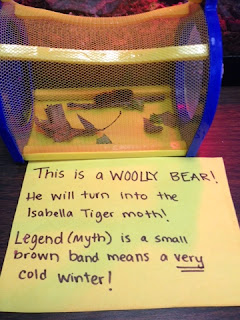Beginning of March 2014
Bunny (Midnight Shadow)
The animals we inherent are usually pets that people no longer want. Personally, I'd rather us be getting animals native the the Hudson River and shorezone... This particular bunny was at the center for a short time a year ago, and seeing him back makes the kids happy and in return makes me happy.
Our bunny supplies aren't great.. the bottom of the cage has a big crack that has a temporary patch up, the water bottle leaks and constantly gets knocked over by the bunny. He's a very active bunny and also knocks over the food dish even when it is full. He's a bit high maintenance..... but we make do. I'm slowly getting kids used to and helping with cleaning out the poo & cage daily.
End of March 2014
House Crickets
Back in January we received a Cricket Breeding Kit from Carolina Biological. It comes with a tiny plastic cage, food, peat pots, soil, and the breeding dishes with mesh. They send about 30 live crickets, except due to extreme cold they were all dead when we received them. We got a second batch shipped to us once it was a little warmer. We decided to put them in a larger tank that we had on hand.
None of us had knowledge or experience with crickets. I've learned the following through trial and error:
- Crickets will drown themselves if you give a full water dish. Wet paper towel works well
- The egg laying dishes need to be sprayed with water daily or sooner, if the soil dries out so do the eggs and they die.
- Crickets do not live for very long
- Crickets, especially cricket eggs, need to be kept in 85+ degrees F temperatures
- It is best to only have substrate in the breeding dish (not dirt everywhere around the cage)
- It is encouraged to remove the egg dish once eggs are deposited and place them in a new tank, then place a new egg dish in the adult cricket tank. (in order to prevent young from being eaten)
All that being said... we now only have one cricket left as of 4/27 :(
Mushrooms
We had a grow your own mushroom kit, which guarantees edible pearl oyster mushrooms will grow in 10 days. It took ours much much longer to grow... so long that I worried they weren't going to grow at all, or that the humidity in our room was a problem. We prepped the "farm" around the second week in March (12/13th). Upon coming into the room on April 7, after the weekend, I was super pleasantly surprised to see mushrooms finally! There was no sign of anything the previous Friday... but some magic seemed to happen that weekend!
The dates of the mushroom photos are: March 31, April 7, April 7, April 8, and April 11. I plucked them off a day or so after April 11th because they had dried out over the weekend.
Unfortunately, my boss didn't want us to eat them because of concern that all the animals in the room (dander, waste, whatever else in the air) would have made them unsafe to eat.
Seedlings
We planted our seeds on March 10 and on the 25th we finally had one sprout! Unfortunately, this is the only one that has sprouted. Future advice to myself: don't use seeds that seem old and especially not if past the package expiration date... even if the package is unopened. This one continues to be growing well. It is the only pot that was planted with Bright Lights seeds
Mid April 2014
Ringed-Neck Pheasants
Hopefully by May 9 our eggs will hatch! Put in the incubator on April 16.
Guinea Pig (Mr.Squeaky)
The same day we got the eggs, we unexpectedly got a guinea pig. Again another pet from pet owners who can no longer care for it. He's not used to people yet and nibbles a bit. ALSO RUNS RIDICULOUSLY FAST. Makes cleaning the cage difficult since he has to be taken out to do so.
.jpg)
.jpg)
.jpg)
.jpg)
.jpg)
.jpg)
.jpg)
.jpg)
.jpg)
.jpg)
.jpg)
.jpg)











.JPG)


























